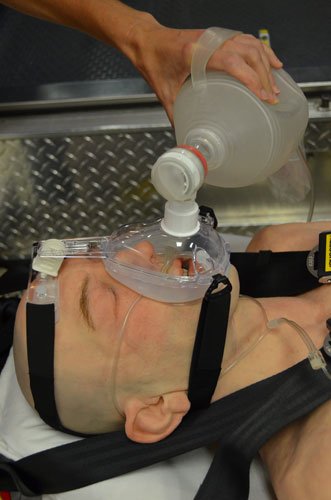Assessing and Treating Deteriorating Respiratory Failure Patients

Effectiveness of CPAP monitored with nasal capnography. Photo by Joe Hopple.
Noninvasive positive pressure ventilation such as CPAP (continuous positive airway pressure) has become a standard of care for the prehospital respiratory distress patients. It helps prevent patients from intubation1, which is thought to improve patient outcomes. However, there are patients that deteriorate and others that suffer adverse reactions2. Recognizing these deteriorating patients and changing our therapy can give these very sick patients the best opportunity for a positive outcome.
Who should not get CPAP?
Just as we now understand not every patient will benefit from application of a non-rebreather mask, not every patient in respiratory failure will be helped by CPAP. Most protocols state if the patient is already hypoventilating, anxious and unable to follow commands, or cannot tolerate CPAP they should not be treated with it3. Assessing your patient accurately early in their care will allow you to select the best treatment plan for your patient. Early application of end tidal carbon dioxide (ETCO2) monitoring will help you to accurately assess the patients ventilatory rate and quality and determine if you need to proceed to bag valve mask (BVM) ventilations. Combined with an accurate history and physical, you can better choose the best course of treatment for your patient.
Recognizing your patient’s deterioration
Constant attention to your patient on CPAP will give you the best chance to recognize your patient’s deterioration and act on it. Watching your patients’ level of consciousness will be an early sign that changing your therapy may be needed. A patient with increasing anxiety may give you a sign that they cannot tolerate the therapy, or that there may be an equipment issue. Be sure to trouble shoot your CPAP equipment starting at the oxygen source to the mask to ensure it is working appropriately. Remove and replace any equipment having issues.
Your patient that is beginning to tire, slump, and show signs such as their chin resting on their chest—these are signs of fatigue and respiratory failure with impending respiratory arrest. Watch for dropping oxygen saturations, bradycardia, and rising ETCO2 levels as diagnostic signs of the impending arrest. Monitoring waveform ETCO2 can reveal a slowing respiratory rate and flattening wave forms indicating hypoventilation4. The stethoscope is the classic assessment tool to assess your respiratory patient. It should not be replaced with the technology available today, but instead used to enhance our knowledge of the patient’s condition. A good baseline lung field assessment can let us track therapy progress and warn us if our CPAP therapy produces the uncommon but serious side effect of a pneumothorax. Using the combination of your physical exam of the patient and your diagnostics can allow you to identify the deterioration and act quickly.

CPAP mask used to initiate BVM ventilation. Photo by Joe Hopple.
The CPAP can still help your patient
If you decide the discontinue your CPAP therapy and move to BVM ventilations, do not completely remove your CPAP but instead continue to use the mask. If you did good preparation and sizing of the mask, you already have a great mask seal you can use to ventilate your patient. The mask connectors are standardized so your BVM will work with your CPAP mask, there is no need to remove it. Also, the ETCO2 cannula you applied to monitor the patient with CPAP can be used to monitor your BVM ventilations of the patient.
You will need to do your basic airway maneuvers off positioning and head tilt / chin lift to allow good BVM ventilations. However, you may not need to press as hard to get a seal since your CPAP mask may be designed to seal with less pressure . If your patient does not improve with BVM ventilations,and you need to insert and adjunct airway you can still use the CPAP mask. Simply unhook one side of the mask tilt it to the side and follow your insertion procedures. You can then simply replace the mask and hook the harness back up to help maintain your seal.
Conclusion
Prehospital CPAP therapy has helped prevent many of our patients from deteriorating to respiratory failure and intubation. However, knowing when the therapy is not right for our patient or not working for our patient and reacting appropriately will allow us to do the most good for this critical patient.
References
- Continuous positive airway pressure and noninvasive ventilation in prehospital treatment of patients with acute respiratory failure: a systematic review of controlled studies. https://www.ncbi.nlm.nih.gov/pmc/articles/PMC4251922/
- Prehospital treatment with continuous positive airway pressure in patients with acute respiratory failure: a regional observational study. https://www.ncbi.nlm.nih.gov/pmc/articles/PMC5057371/
- CPAP Best Practices. https://www.jems.com/articles/2010/12/cpap-best-practices.html
- How to Read and Interpret End-Tidal Capnography Waveforms. https://www.jems.com/articles/print/volume-42/issue-8/features/how-to-read-and-interpret-end-tidal-capnography-waveforms.html
Joseph P. Hopple, NRP, is the former education coordinator for Sussex County EMS and is currently the director of emergency services for Old Lycoming Township in Williamsport, Pa, where he also serves on the faculty of the Pennsylvania College of Technology Paramedic program.


Good article; however the application of a PEEP valve to the BVM should have been included.